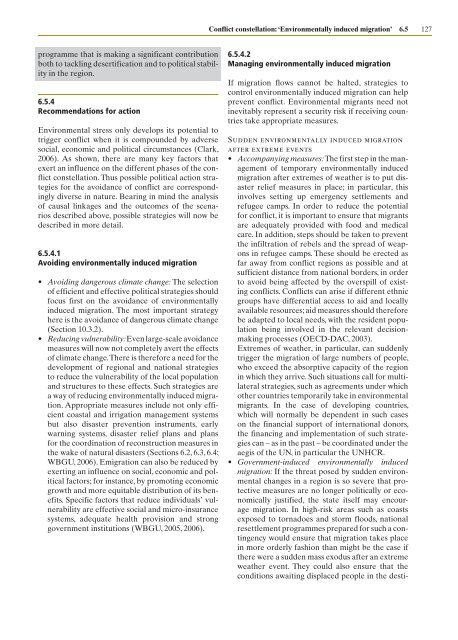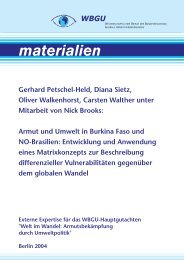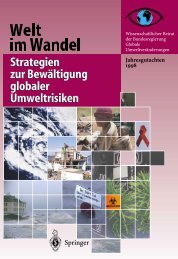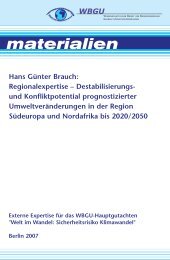World in Transition: Climate Change as a Security Risk - WBGU
World in Transition: Climate Change as a Security Risk - WBGU
World in Transition: Climate Change as a Security Risk - WBGU
Create successful ePaper yourself
Turn your PDF publications into a flip-book with our unique Google optimized e-Paper software.
programme that is mak<strong>in</strong>g a significant contribution<br />
both to tackl<strong>in</strong>g desertification and to political stability<br />
<strong>in</strong> the region.<br />
6.5.4<br />
Recommendations for action<br />
Environmental stress only develops its potential to<br />
trigger conflict when it is compounded by adverse<br />
social, economic and political circumstances (Clark,<br />
2006). As shown, there are many key factors that<br />
exert an <strong>in</strong>fluence on the different ph<strong>as</strong>es of the conflict<br />
constellation. Thus possible political action strat<br />
egies for the avoidance of conflict are correspond<strong>in</strong>gly<br />
diverse <strong>in</strong> nature. Bear<strong>in</strong>g <strong>in</strong> m<strong>in</strong>d the analysis<br />
of causal l<strong>in</strong>kages and the outcomes of the scenarios<br />
described above, possible strategies will now be<br />
described <strong>in</strong> more detail.<br />
6.5.4.1<br />
Avoid<strong>in</strong>g environmentally <strong>in</strong>duced migration<br />
Avoid<strong>in</strong>g dangerous climate change: The selection<br />
of efficient and effective political strategies should<br />
focus first on the avoidance of environmentally<br />
<strong>in</strong>duced migration. The most important strategy<br />
here is the avoidance of dangerous climate change<br />
(Section 10.3.2).<br />
Reduc<strong>in</strong>g vulnerability: Even large-scale avoi dance<br />
me<strong>as</strong>ures will now not completely avert the effects<br />
of climate change. There is therefore a need for the<br />
development of regional and national strategies<br />
to reduce the vulnerability of the local population<br />
and structures to these effects. Such strategies are<br />
a way of reduc<strong>in</strong>g environmentally <strong>in</strong>duced migration.<br />
Appropriate me<strong>as</strong>ures <strong>in</strong>clude not only efficient<br />
co<strong>as</strong>tal and irrigation management systems<br />
but also dis<strong>as</strong>ter prevention <strong>in</strong>struments, early<br />
warn<strong>in</strong>g systems, dis<strong>as</strong>ter relief plans and plans<br />
for the coord<strong>in</strong>ation of reconstruction me<strong>as</strong>ures <strong>in</strong><br />
the wake of natural dis<strong>as</strong>ters (Sections 6.2, 6.3, 6.4;<br />
<strong>WBGU</strong>, 2006). Emigration can also be reduced by<br />
exert<strong>in</strong>g an <strong>in</strong>fluence on social, economic and political<br />
factors; for <strong>in</strong>stance, by promot<strong>in</strong>g economic<br />
growth and more equitable distribution of its benefits.<br />
Specific factors that reduce <strong>in</strong>dividuals’ vulnerability<br />
are effective social and micro-<strong>in</strong>surance<br />
systems, adequate health provision and strong<br />
government <strong>in</strong>stitutions (<strong>WBGU</strong>, 2005, 2006).<br />
Conflict constellation: ‘Environmentally <strong>in</strong>duced migration’ 6.5<br />
6.5.4.2<br />
Manag<strong>in</strong>g environmentally <strong>in</strong>duced migration<br />
If migration flows cannot be halted, strategies to<br />
control environmentally <strong>in</strong>duced migration can help<br />
prevent conflict. Environmental migrants need not<br />
<strong>in</strong> evitably represent a security risk if receiv<strong>in</strong>g countries<br />
take appropriate me<strong>as</strong>ures.<br />
Sudden environmentally <strong>in</strong>duced migration<br />
after extreme events<br />
Accompany<strong>in</strong>g me<strong>as</strong>ures: The first step <strong>in</strong> the management<br />
of temporary environmentally <strong>in</strong>duced<br />
migration after extremes of weather is to put dis<strong>as</strong>ter<br />
relief me<strong>as</strong>ures <strong>in</strong> place; <strong>in</strong> particular, this<br />
<strong>in</strong>volves sett<strong>in</strong>g up emergency settlements and<br />
refugee camps. In order to reduce the potential<br />
for conflict, it is important to ensure that migrants<br />
are adequately provided with food and medical<br />
care. In addition, steps should be taken to prevent<br />
the <strong>in</strong>filtration of rebels and the spread of weapons<br />
<strong>in</strong> refugee camps. These should be erected <strong>as</strong><br />
far away from conflict regions <strong>as</strong> possible and at<br />
sufficient distance from national borders, <strong>in</strong> order<br />
to avoid be<strong>in</strong>g affected by the overspill of exist<strong>in</strong>g<br />
conflicts. Conflicts can arise if different ethnic<br />
groups have differential access to aid and locally<br />
available resources; aid me<strong>as</strong>ures should therefore<br />
be adapted to local needs, with the resident population<br />
be<strong>in</strong>g <strong>in</strong>volved <strong>in</strong> the relevant decisionmak<strong>in</strong>g<br />
processes (OECD-DAC, 2003).<br />
Extremes of weather, <strong>in</strong> particular, can suddenly<br />
trigger the migration of large numbers of people,<br />
who exceed the absorptive capacity of the region<br />
<strong>in</strong> which they arrive. Such situations call for multilateral<br />
strategies, such <strong>as</strong> agreements under which<br />
other countries temporarily take <strong>in</strong> environmental<br />
migrants. In the c<strong>as</strong>e of develop<strong>in</strong>g countries,<br />
which will normally be dependent <strong>in</strong> such c<strong>as</strong>es<br />
on the f<strong>in</strong>ancial support of <strong>in</strong>ternational donors,<br />
the f<strong>in</strong>anc<strong>in</strong>g and implementation of such strategies<br />
can – <strong>as</strong> <strong>in</strong> the p<strong>as</strong>t – be coord<strong>in</strong>ated under the<br />
aegis of the UN, <strong>in</strong> particular the UNHCR.<br />
Government-<strong>in</strong>duced environmentally <strong>in</strong>duced<br />
migration: If the threat posed by sudden environmental<br />
changes <strong>in</strong> a region is so severe that protective<br />
me<strong>as</strong>ures are no longer politically or economically<br />
justified, the state itself may encourage<br />
migration. In high-risk are<strong>as</strong> such <strong>as</strong> co<strong>as</strong>ts<br />
exposed to tornadoes and storm floods, national<br />
resettlement programmes prepared for such a cont<strong>in</strong>gency<br />
would ensure that migration takes place<br />
<strong>in</strong> more orderly f<strong>as</strong>hion than might be the c<strong>as</strong>e if<br />
there were a sudden m<strong>as</strong>s exodus after an extreme<br />
weather event. They could also ensure that the<br />
conditions await<strong>in</strong>g displaced people <strong>in</strong> the desti-<br />
127
















